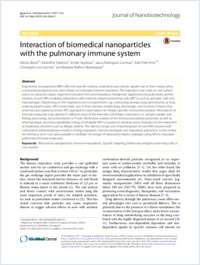Interaction of biomedical nanoparticles with the pulmonary immune system
- Blank, Fabian Respiratory Medicine, Bern University Hospital, University of Bern, Switzerland
- Fytianos, Kleanthis Adolphe Merkle Institute, University of Fribourg, Switzerland
- Seydoux, Emilie Respiratory Medicine, Bern University Hospital, University of Bern, Switzerland
- Rodriguez-Lorenzo, Laura Adolphe Merkle Institute, University of Fribourg, Switzerland
- Petri-Fink, Alke Adolphe Merkle Institute, University of Fribourg, Switzerland - Chemistry Department, University of Fribourg, Switzerland
- Garnier, Christophe von Respiratory Medicine, Bern University Hospital, University of Bern, Switzerland
- Rothen-Rutishauser, Barbara Adolphe Merkle Institute, University of Fribourg, Switzerland
-
2017
Published in:
- Journal of Nanobiotechnology. - 2017, vol. 15, p. 6
English
Engineered nanoparticles (NPs) offer site-specific delivery, deposition and cellular uptake due to their unique physicochemical properties and were shown to modulate immune responses. The respiratory tract with its vast surface area is an attractive target organ for innovative immunomodulatory therapeutic applications by pulmonary administration of such NPs, enabling interactions with resident antigen-presenting cells (APCs), such as dendritic cells and macrophages. Depending on the respiratory tract compartment, e.g. conducting airways, lung parenchyma, or lung draining lymph nodes, APCs extensively vary in their number, morphology, phenotype, and function. Unique characteristics and plasticity render APC populations ideal targets for inhaled specific immunomodulators. Modulation of immune responses may operate in different steps of the immune cell-antigen interaction, i.e. antigen uptake, trafficking, processing, and presentation to T cells. Meticulous analysis of the immunomodulatory potential, as well as pharmacologic and biocompatibility testing of inhalable NPs is required to develop novel strategies for the treatment of respiratory disorders such as allergic asthma. The safe-by-design and characterization of such NPs requires well coordinated interdisciplinary research uniting engineers, chemists biologists and respiratory physicians. In this review we will focus on in vivo data available to facilitate the design of nanocarrier-based strategies using NPs to modulate pulmonary immune responses.
- Faculty
- Faculté des sciences et de médecine
- Department
- Département de Chimie
- Language
-
- English
- Classification
- Biological sciences
- License
-
License undefined
- Identifiers
-
- RERO DOC 288581
- DOI 10.1186/s12951-016-0242-5
- Persistent URL
- https://folia.unifr.ch/unifr/documents/305479
Statistics
Document views: 107
File downloads:
- pdf: 144
